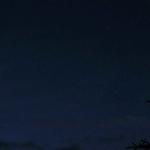
When the Neowise comet started trending online, Alaskans saw it as an opportunity to go comet-hunting. Stargazers across the continent have been posting photos of the comet as it hurtles through space, but with Juneau’s weather bringing lots of clouds and rain, seeing the comet has been a tough game of chance.
Longtime Juneauite Jim Hale considers himself an amateur astronomer. He was lucky enough to witness Halley’s comet in 1986 and Hale-Bopp in 1996, but Wise had no luck trying to see Neowise last week from Eagle Beach.
“I was out there past midnight, when finally it got dark enough, and I knew about where this comet was supposed to be. I could see the Big Dipper, but just where the comet was supposed to be, the clouds had moved in.”
Mark Conde, a physics professor at the University of Alaska Fairbanks, says Neowise may be a visitor from a zone of space beyond Neptune called the Kuiper Belt. Astronomers were surprised when the Neowise orbiting satellite — which looks for objects that could potentially threaten Earth — spotted the comet on March 27.
But no need to worry about any cosmic collision. Conde says there’s absolutely no chance the comet will hit earth. It’s about 66 million miles away.
On a relatively clear night, the chances of seeing the comet are better down south, where it’s darker, than they are up north. Conde says the best time to see it would be around 2 a.m., and it will be closest to the earth on Thursday, July 23.
If you’re looking for Neowise, Conde says the comet should look like a “fuzzy little star” below the Big Dipper.
“If you look a bit more carefully and let yourself sort of, you know, let your brain see deep into the sky,” Conde said, “you should start to see a tail that’s hitting up and to the right of the comet.”
Juneau locals Jennifer Karnik and Rob Mayer already caught a glimpse of the comet last week. Karnik says they didn’t have much hope of seeing it at first.
“We’re in Juneau, you know, never going to see anything, you know, kind of given up on it,” she said.
When conditions improved, they decided to make the trek up to Eaglecrest on Douglas Island.
“Wednesday afternoon comes along, and the sky starts brightening and the clouds start parting,” Karnik said. “We watched through the evening and decided around nine o’clock or so that it was worth at least giving it a try.”
Karnik and Mayer watched the clouds as they waited. It wasn’t until about 11:30 p.m. that they could see most of the cloudless sky.
“You could actually see the comet with your naked eyes,” Karnik said. “I mean, it was just actually in the sky. I think I yelled.”
Karnik got a decent shot of the comet with her smartphone through the telescope. Mayer, who is an avid astrophotographer, took a 4-second exposure with his camera.
“I was very happy to at least get three images that were at a sharp, perfect focus out of the 40 or so that I took,” he said.
And they truly are once-in-a-lifetime photos. According to EarthSky.org, this comet won’t return for another 6,800 years.






